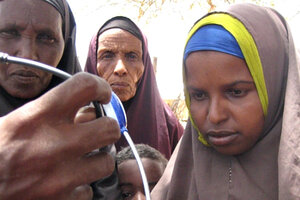In Kenya solar lamps reduce childbirth risks
Instead of relying on moonlight or dangerous and smoky kerosene lamps, midwives now use solar-powered lamps to make childbirth safer in remote regions of Kenya that are off the electric grid.

Hasna Muktar, a birth attendant, shows a solar lamp she uses during deliveries and women's education programs to other women in Sankuri village in northern Kenya.
AlertNet/Abjata Khalif
Garissa, Kenya
Hasna Muktar, a traditional birth attendant in remote Sankuri village in northern Kenya, has met her share of challenges while delivering babies, from snakebites and threatening hyenas to the choking fumes of kerosene lamps that are widely used to provide a feeble light at night-time deliveries.
But that last problem, at least, is now being overcome, thanks to the installation of solar panels and bright, low-energy LED lights.
‘’The solar lamp has made my deliveries and women's education work simple, as I charge it during the day and start using it at night,” Muktar said. “In the past we use to worry on the cost of the kerosene but now everything is in front of our door.’’
Sankuri village is 300 kilometers (186 miles) from the main regional town of Garissa, and the arid area has poor communication and transport networks, forcing residents to use donkey carts and camels to ferry patients to hospitals.
The journey takes seven days to Garissa, and many patients die on the way before receiving medical attention. Women in labor are particularly vulnerable, with obstructed delivery often resulting in fistula or the death of mother and child.
But traditional midwives in Sankuri offer an alternative – and one that is now solar-powered.
As the scorching sun sets on the horizon, a group of eight heavily pregnant women walk into the expansive compound where Muktar has her "delivery room," consultation room, and training room, where she educates both pregnant and other women on behavioral change and family planning.
The facility is built with sticks and grass, and the only source of water is from a shallow well. There is no electricity.
The lack of power in the past meant Muktar had to use a kerosene lamp at night to attend to births and other emergencies, and to wind her way through the bush and along village paths to home facing dangers such as snake bites, attack by hyenas, and stepping on thorn trees used for fencing.
‘’For 25 years I have been using kerosene lamps, and sometime bright lights from the moon. I have been bitten three times by snakes and that affected my work and inconvenienced many pregnant women in Sankuri village,” she said.
As well, “the kerosene lamp made health problems both to me and mothers with their newborn babies. I have contracted respiratory infections on various occasions, and also the use of moonlight is quite tricky as I have to conduct deliveries in the open air. I use moonlight only when kerosene is out of stock or when I contract respiratory sickness,‘’ she said.
But now Muktar and other traditional birth attendants have less to worry about after receiving portable solar LED lamps and solar panels to charge them from Pajan Kenya, a local nongovernmental group backed by the international NGO Afri-Ireland.
The system, which has been delivered to 30 traditional birth attendants, takes five hours of sunshine to charge lamps that then last as long as 12 hours.
The lamps are used by the birth attendants to attend to women at night, and also during women’s education sessions, where a traditional attendant congregates more than 20 pregnant women at her compound to go through family planning and behavioral change education.
Muktar said she has already used the lamp during 185 births in Sankuri village – and that the technology is bringing down the cost she must charge for her services. Formerly, she said, she charged about 425 Kenyan shillings ($5) for a delivery, including the costs of kerosene, transported from Garissa. Now a birth costs 255 Kenyan shillings ($3).
Pajan Kenya, the organization educating traditional birth attendants on the use of solar lamps, says the project is an example of green energy empowering grass-roots women and contributing to reductions in maternal and child mortality in remote areas with few health facilities.
Two thirds of Kenya's maternal deaths are attributed to postpartum hemorrhage (severe loss of blood during or after labor), sepsis (bacterial infection in the blood), eclampsia (hypertension during pregnancy), or a ruptured uterus.
According to the last demographic health survey, released by the government, Kenya has one of the highest maternal death rates in the world at 448 per 100,000 live births. Seventy percent of women in northern Kenya deliver under the care of traditional birth attendants, while 30 percent give birth at a hospital, figures show.
• Abjata Khalif is a freelance journalist, based in Wajir, Kenya, with an interest in climate change issues.
• This article originally appeared at AlertNet, a humanitarian news site operated by the Thomson Reuters Foundation.

